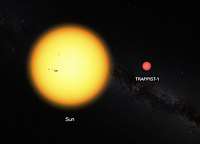Ultra-cool dwarf
An ultra-cool dwarf is a stellar or sub-stellar object of spectral class M that has an effective temperature under 2,700 K (2,430 °C; 4,400 °F).[1] TRAPPIST-1 is one of the best known examples of an ultra-cool dwarf star.[2] The category of ultra-cool dwarf stars was introduced in 1997 by J. Davy Kirkpatrick, Todd J. Henry, and Michael J. Irwin. Today it includes very low mass M-dwarf stars with spectral types of M7 and later, and extends beyond the coolest stars to brown dwarfs as cool as spectral type T6.5. Together, they represent about 15% of astronomical objects in the stellar neighborhood of the Sun.[3]

Models of the formation of planets suggest that due to their low masses and the small size of their proto-planetary disks, these stars could host a relatively abundant population of Earth-like planets ranging from Mercury-size to Earth-size instead of super-Earths and Jupiter-massed planets. The discovery of the TRAPPIST-1 system of seven Earth-like planets seems to validate this accretion model.[4]
Due to their slow hydrogen fusion compared to other types of low mass stars their life spans are estimated at several hundred billion years, with the smallest living for a few trillion years. As the age of the universe is only 13.8 billion years, all ultra-cool dwarf stars are relatively young. Models predict that at the ends of their lives the smallest of these stars will become blue dwarfs instead of expanding into red giants.[5]
Magnetic properties
After the detection of bursts of radio emission from the M9 ultracool dwarf LP 944-20 in 2001, a number of astrophysicists began observing programs at the Arecibo Observatory and the Very Large Array to search for additional objects that emit radio waves. To date hundreds of ultracool dwarfs have been observed with these radio telescopes and over a dozen such radio-emitting ultracool dwarfs have been found.[6] These surveys indicate that approximately 5-10% of ultracool dwarfs emit radio waves. Among the more noteworthy, 2MASS J10475385+2124234, with a temperature of 800-900 K, is the coolest known radio-emitting brown dwarf. It is a T6.5 brown dwarf that retains a magnetic field with a strength larger than 1.7 kG, making it some 3000 times stronger than the Earth's magnetic field.[7]
References
- Gillon, Michaël; Jehin, Emmanuël; Lederer, Susan M; Delrez, Laetitia; De Wit, Julien; Burdanov, Artem; Van Grootel, Valérie; Burgasser, Adam J; Triaud, Amaury H. M. J; Opitom, Cyrielle; Demory, Brice-Olivier; Sahu, Devendra K; Bardalez Gagliuffi, Daniella; Magain, Pierre; Queloz, Didier (2016). "Temperate Earth-sized planets transiting a nearby ultracool dwarf star". Nature. 533 (7602): 221. arXiv:1605.07211. Bibcode:2016Natur.533..221G. doi:10.1038/nature17448. PMC 5321506. PMID 27135924.
- Gillon, Michaël (May 5, 2017). "Ultra-Cool Dwarf Stars May Host Planets With Ultra-Cool Life". Vice.com. Retrieved 27 April 2020.
- Cantrell, Justin R.; Henry, Todd J.; White, Russel J. (13 September 2013). "THE SOLAR NEIGHBORHOOD XXIX: THE HABITABLE REAL ESTATE OF OUR NEAREST STELLAR NEIGHBORS". The Astronomical Journal. 146 (4): 99. arXiv:1307.7038. Bibcode:2013AJ....146...99C. doi:10.1088/0004-6256/146/4/99.
- "NASA Telescope Reveals Largest Batch of Earth-Size, Habitable-Zone Planets Around Single Star". NASA. Retrieved 2017-11-19.
- Adams, F. C.; P. Bodenheimer; G. Laughlin (2005). "M dwarfs: planet formation and long term evolution". Astronomische Nachrichten. 326 (10): 913–919. Bibcode:2005AN....326..913A. doi:10.1002/asna.200510440.CS1 maint: ref=harv (link)
- Route, M.; Wolszczan, A. (20 October 2016). "The Second Arecibo Search for 5 GHz Radio Flares from Ultracool Dwarfs". The Astrophysical Journal. 830: 85. arXiv:1608.02480. Bibcode:2016ApJ...830...85R. doi:10.3847/0004-637X/830/2/85.
- Route, M.; Wolszczan, A. (10 March 2012). "The Arecibo Detection of the Coolest Radio-flaring Brown Dwarf". The Astrophysical Journal Letters. 747: L22. arXiv:1202.1287. Bibcode:2012ApJ...747L..22R. doi:10.1088/2041-8205/747/2/L22.
